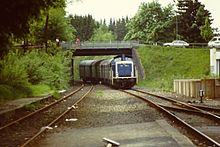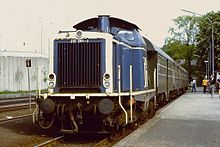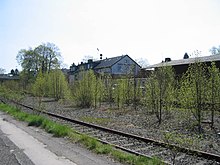Wippertal Railway
| Bergisch Born – Marienheide | |||||||||||||||||||||||||||||||||||||||||||||||||||||||||||||||||||||||||||||||||||||||||||||||||||||
|---|---|---|---|---|---|---|---|---|---|---|---|---|---|---|---|---|---|---|---|---|---|---|---|---|---|---|---|---|---|---|---|---|---|---|---|---|---|---|---|---|---|---|---|---|---|---|---|---|---|---|---|---|---|---|---|---|---|---|---|---|---|---|---|---|---|---|---|---|---|---|---|---|---|---|---|---|---|---|---|---|---|---|---|---|---|---|---|---|---|---|---|---|---|---|---|---|---|---|---|---|---|
| Route number : | 2707 | ||||||||||||||||||||||||||||||||||||||||||||||||||||||||||||||||||||||||||||||||||||||||||||||||||||
| Course book section (DB) : | last 412 | ||||||||||||||||||||||||||||||||||||||||||||||||||||||||||||||||||||||||||||||||||||||||||||||||||||
| Route length: | 31 km | ||||||||||||||||||||||||||||||||||||||||||||||||||||||||||||||||||||||||||||||||||||||||||||||||||||
| Gauge : | 1435 mm ( standard gauge ) | ||||||||||||||||||||||||||||||||||||||||||||||||||||||||||||||||||||||||||||||||||||||||||||||||||||
|
|||||||||||||||||||||||||||||||||||||||||||||||||||||||||||||||||||||||||||||||||||||||||||||||||||||
The Wipper Valley Railway was a non-electrified, single-track, 31 km long railway line from Bergisch Born about Wipperfürth to Marienheide . The route was gradually closed until 1995 and largely converted into a cycle and walkway by 2012 .
history
opening
The Wippertal Railway started on May 13, 1876 with the opening of the first section from the Lennep railway junction . On the same day, the branch line from Lennep to Wermelskirchen , branching off in Bergisch Born, was inaugurated, which later continued to Opladen . The first section of the Wippertalbahn had connections from Cologne , Barmen - Elberfeld and Solingen to Hückeswagen. It was extended to December 22 of the same year for goods traffic and January 2, 1877 for passenger traffic to Wipperfürth. The reason for the construction was the increased demands on a usable transport infrastructure of the growing industry on the Wupper.
In 1893, the railway expanded the section between Lennep and Bergisch Born to two tracks, and at the same time the train station in Winterhagen and the stop in Hammern (with a station building) were built. The section to Marienheide only went into operation on January 15, 1902, where there was now a connection to the Volmetalbahn from Hagen to Dieringhausen and the narrow-gauge Leppetalbahn .
Until the Weimar Republic
In 1905 there were already eleven pairs of passenger trains (two of them between Lennep and Wipperfürth) every day. From 1907 there was a pair of passenger trains from Wuppertal all the way to Oberbergisches . This most famous connection on the route led from Wuppertal via Remscheid to Marienheide on the Volmetalbahn and Aggertalbahn to the Wiehl Valley Railway to Waldbröl . It stayed on the timetable for an unusually long time. From 1907 to 1964 (after the Wiehl Valley Railway was shut down until 1979 with the destination Dieringhausen), this connection existed continuously, except for interruptions due to the war.
In 1909, benzene-electric railcars ran between Lennep and Wipperfürth for the first time, increasing the timetable on this section by eight pairs of trains.
The First World War brought severe restrictions in traffic, and many train services were canceled. In addition, there was the problem that France occupied the Ruhr area, Hückeswagen became the border between the occupied and unoccupied area. In some cases the occupiers stopped all traffic. This situation lasted until the end of the occupation on October 22, 1924.
Until the end of World War II
From May 15, 1931, express trains also ran on the route. An example of this was an express train from Wuppertal via the Wippertalbahn to the Volmetalbahn to Dieringhausen, and from there on to the Aggertalbahn to Olpe . Like the other branch lines such as the eastern Aggertalbahn, the Wippertalbahn also played a role as a diversion route during the Second World War in order to keep numerous freight trains away from the main lines, which were in danger of being bombed . But the track also hit it. On March 22, 1945, Allied bombers destroyed the Hückeswagen station, and at about the same time the one in Wipperfürth. In September 1945, the train service could temporarily be resumed.
Decline
Between 1952 and 1955, new stops were created (Bevertalsperre, Wipperfürth West, Wipperfürth Ost and Klaswipper), which were served by the rail buses newly introduced in 1952 from the Wuppertal-Steinbeck depot. As a result of these new vehicles, the timetable increased, and as a result, the number of passengers.
In the summer of 1960, general cargo handling was closed at the Winterhagen and Ohl-Rönsahl stations. This was a measure that significantly reduced the volume of goods on the route. The line branching off in Wipperfürth after the stop on the Wuppertal Railway was shut down at the same time. In 1961, a replacement for the station building in Wipperfürth that had been destroyed in the war was inaugurated.
On May 29, 1965, freight traffic between Wipperfürth and Marienheide and the through freight trains from Dieringhausen to Lennep ended. The Winterhagen train station was converted into a stop on October 1, 1973, and the train crossings that had taken place there until then were relocated to Hückeswagen.
The last few years until the shutdown
In 1975 there was a major reform of general cargo, to which the loading points in the entire Oberberg district fell victim, including in Marienheide, Wipperfürth and Hückeswagen. As a result, the volume of goods decreased even further. After that, truckloads were only loaded once a day. There was also a weekend rest. All trains were canceled between Saturday afternoon and Monday morning. The bus traffic in the region was expanded and drove on competition at the same time as the railways. However, the buses were also on the road a little longer than the rail buses on the tracks. In 1980 the series 798 and 795 rail buses, which had dominated until then, were replaced by locomotive-hauled trains. But with four, later two or three cars, they had a much larger number of seats.
In addition, the trains only ran between Lennep and Marienheide and not beyond as before. With the conversion to locomotive-hauled trains, the Klaswipper stop was abandoned. Shortly afterwards, in 1982, the Federal Railroad introduced train control between Bergisch-Born and Marienheide. On May 23, 1982, the Gogarten and Egerpohl stops were closed and the Hückeswagen station was demoted to a stop.
On June 1, 1985, the goods and passenger traffic between Wipperfürth-Ost and Marienheide was stopped. The Lennep-Wipperfürth-Ost section had to be used for the school traffic of the grammar school at the Wipperfürth-Ost stop due to the lack of a bus replacement. Just one year later, on May 31, 1986, after 110 years there was also the cessation of passenger transport, which was taken over by a railway bus line. After that there were only a few special trains left. The track between Marienheide and Wipperfürth was quickly dismantled in October 1986 after plans by an association to set up a museum railway became known. Up until December 30, 1995, there was still meager freight traffic between Bergisch Born and Wipperfürth.
Since the shutdown


In 1998 the route security agreement ended. The route between Marienheide and Wipperfürth was converted into a cycle path . Reactivation efforts were unsuccessful. Originally for 2009, then for 2010, the construction of a cycle path from Wipperfürth to Hückeswagen was planned along the old railway line, which was later continued in a further construction phase to the local border to Remscheid. The continuous cycle path has now been implemented.
In March 2009, the section between Wipperfürth and Hückeswagen was cut open in order to be able to use the tracks again (after well-attended special trips with a rail vehicle). Following this, the tracks were dismantled as planned.
In addition, the route, like others in the region, was deleted from the regional plan of the state of North Rhine-Westphalia with an announcement of March 12, 2008, the announcing regional council of the administrative district of Cologne wrote: “By removing this route from the public transport requirement plan, the state parliament of North Rhine-Westphalia has made it clear made that a state interest in maintaining this railroad no longer exists. Deleting this railway line from the regional plan is intended to improve the planning security of the municipalities in urban development. ”From this it follows that the route should in future remain in the hands of the municipalities as a cycle path, but not in its full length.
Operating points
- Winterhagen train station
The station building in Winterhagen was in ruins for a long time, but was then completely renovated, with a major change in appearance.
- Hückeswagen station
First there was a locomotive station with a turntable. The locomotive station in Hückeswagen was closed in 1910 and replaced by one in Wipperfürth when the branch line to the stop was opened. The water tower in Hückeswagen was used until 1955 and demolished in 1960. Allied bombers destroyed Hückeswagen station on March 22, 1945. The Hückeswagen station, which was destroyed in the war, was only demolished in 1952. On October 27, 1956, the railway inaugurated a new station building. On May 23, 1982, the Hückeswagen station was demoted to a stop.
The reception building in Hückeswagen, rebuilt after the Second World War, served as a home for asylum seekers until 2000 and was then torn down, the clock from the clock tower now belongs to a private person. At the same place, a settlement cooperative erected a larger building which today houses shops, restaurants, offices and parts of the city administration. Since 2011, a showcase with various exhibits has been a reminder of the train station.
- Wipperfürth railway station
In Wipperfürth, a special operational feature was a turntable at the end of the line for turning the locomotives, but this was omitted when the building was continued to Marienheide and was replaced by a switch. The station was badly hit by Allied bombers around March 1945. The locomotive station in Wipperfürth stood until the 1950s. In the 1950s, the old, smaller station building was also replaced by a new building.
A youth art school (KuBa - Kunstbahnhof Wipperfürth) has been located in the entrance building of the station since 2009. The old engine shed in Wipperfürth was demolished in the same year. Since 2007, for example, there were no more tracks in Wipperfürth except for the train station. The last tracks were dismantled in March 2011.
From 2011 to 2015, only the station building with a platform and place name sign and a pedestrian bridge that was hardly used in the 1980s reminded of the old train station.
In April 2015, a renovated rail bus was exhibited as a memorial on the station premises. In addition, old tracks were relocated and a buffer stop and a signal were set up again. This memorial commemorates both the history of the railway and the location of a transit camp for refugees, which was established by the British in 1945 and existed until 1960.
- Ohl-Rönsahl station
On May 30, 1965, the Ohl-Rönsahl station was converted into a stop. The reception building still stands today and is privately owned.
- Marienheide station
Marienheide developed into a large railway junction with a locomotive station (branch of the Bruges depot), which also resulted in extensions with new platforms and tracks. Around 1941, the exact date is not known, the locomotive station was closed. After the last passenger traffic to Cologne ( Volmetalbahn ) was shut down, Marienheide station was reduced to the most necessary operating facilities and tracks, only the main track remained. Today there is again local rail transport from Cologne to Marienheide, since 2014 also to Meinerzhagen and since 2017 to Lüdenscheid . With the reactivation of the line to Meinerzhagen, the stop was given a stump track for storage and is therefore officially a train station. The reception building is still standing, but is no longer in use as such today.
Vehicle use
The Wippertalbahn was partly used for passenger traffic from 1909 onwards with benzene-electric railcars, and from the 1950s on with rail buses. Since the railbuses were converted to locomotive-hauled trains in 1980, the route has been driven by class 211 diesel locomotives , more rarely 212, 215, 216, 218 and type 4yg conversion cars.
From 1957, a Köf II small locomotive was used in shunting operations; it was stationed in Wipperfürth.
Accidents
On November 25, 1958, two freight trains collided at the Gogarten stop, causing considerable property damage and seriously injured locomotive personnel. The fault was the dispatcher in Marienheide, who released the freight train in Ohl-Rönsahl and the ballast train in Marienheide for exit. The trains could no longer be stopped and collided on the single-track line. Why the dispatcher allowed both trains to run at the same time could not be clarified. After the accident, the route between Marienheide and Ohl-Rönsahl was closed for almost two weeks.
See also
literature
- Sascha Koch, Horst Kowalski and others: Railways in Oberberg and the history of the Dieringhausen depot. Martina Galunder-Verlag, Nümbrecht 2005, ISBN 3-89909-050-0 .
- Eisenbahnfreunde Remscheid e. V .: Railways in Remscheid , Martina Galunder-Verlag, Nümbrecht 2005, ISBN 3-89909-060-8 .
- Axel Johanßen: From the embankment to the parking lot. Railway impressions yesterday and today from the Rhineland - yesterday and today. Galunder Verlag, Nümbrecht 2007, ISBN 978-3-89909-080-2 .
- Bernd Franco Hoffmann: Disused railway lines in the Bergisches Land. Sutton-Verlag, Erfurt April 2013, ISBN 978-3-95400-147-7 .
- Bernd Franco Hoffmann: The Bergisch-Märkische Eisenbahn. Through the valleys of Wupper, Ruhr and Volme ; Sutton-Verlag, Erfurt 2015, ISBN 978-3954005802
- Kurt Kaiß, Thomas Kugel, Michael Peplies: From Lennep to Oberbergische. The Lennep-Hückeswagen-Wipperfürth-Marienheide railway line. Rheinisch-Bergische Eisenbahngeschichte, Volume 8, Verlag A. Kaiß, Leichlingen 2018, ISBN 978-3-9818345-0-5
Web links
- Newspaper article about the planned closure of Gummersbach-Wipperfürth-Lennep in 1961
- Description of the line 2707 (Bergisch Born - Marienheide) in the NRWbahnarchiv by André Joost
- Collection of historical photos
- Condition of the Wippertal Railway in 2004
- Axel Johanßen: Incomparable from Wipperfürth (m31B)
- The history of the Wippertalbahn with current photos
- Article about the inauguration of Wipperfürth station in March 1961
- Photos from the operation in the 1980s
- Remscheid-Lennep - Wipperfürth- Marienheide (May 30, 1985) (m8B)
- Newspaper articles about Wipperfürth buys rail bus, railway site is to become a museum
Individual evidence
- ↑ http://www.modellbahnwoche.de/wordpress/wp-content/uploads/2011/03/KR-Wipperfuerth.jpg
- ↑ modellbahnwoche.de: The history of the Wippertalbahn part 2 , accessed on January 7, 2011
- ↑ Textual representation 14. Change of plan (PDF; 185 kB) Archived from the original on August 15, 2011. Info: The archive link was inserted automatically and has not yet been checked. Please check the original and archive link according to the instructions and then remove this notice. Retrieved January 7, 2011.
- ↑ OpenStreetMap railway cycle path Bergisch Born - Marienheide
- ↑ http://www.pro-schiene.de/2005/bergisch_marienheide.html
- ↑ http://www.oberberg-aktuell.de/index.php?id=144&tx_ttnews%5Btt_news%5D=167687
- ↑ Turntable Online: After the Bergische submitted yesterday evening ..... (with 1 scan and 9.B) , accessed on March 20, 2010





